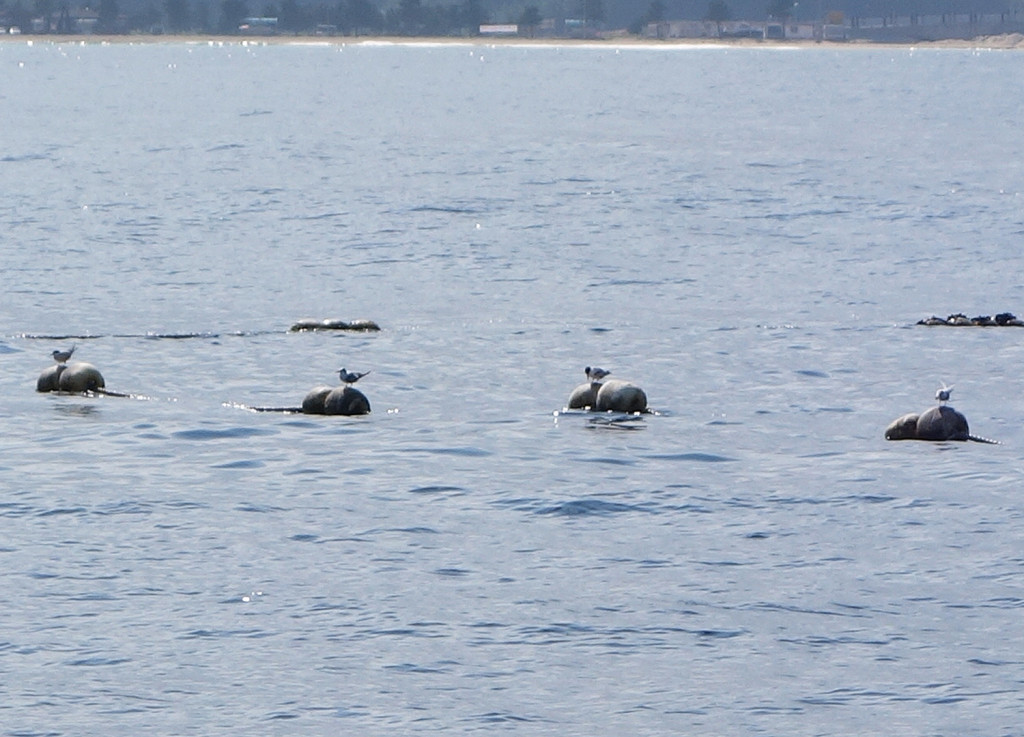Bird News from Nial Moores (Birds Korea) with Choi Hyun-Ah (Hanns Seidel Foundation, Korea)
A second bird survey in Goseong County (after the first in late June) was conducted with the Hanns Seidel Foundation, Korea, as part of research on biodiversity conservation close to the inner border region. The survey, as well as demonstrating that life remains “normal” here in Korea (with no obvious sense of heightened tension), included four hours on a boat (going a maximum of 12.8km out) and three hours by Daejin lighthouse, both on September 3rd; followed by three hours of “fixed point” counting from the excellent January Pension, just to the south of the harbor from 15 minutes before sunrise on the 4th.
 The coast off Daejin, looking north to the DPRK from 3km out © Nial Moores
The coast off Daejin, looking north to the DPRK from 3km out © Nial Moores
In total, I logged 50 bird species, including 35 species that are either marine preferential or were undertaking active migration over the sea.
Early autumn migrants included good numbers of Common Tern, with 815 from the boat, many roosting on mariculture platforms, and 1,270 seen in a single scan on the 3rd (with presumably much overlap in individuals).
 Maritime platforms were used by large numbers of roosting Common Terns © Nial Moores
Maritime platforms were used by large numbers of roosting Common Terns © Nial Moores
There was also a good mix of duck species, with 287 duck counted flying south on the 4th (including 71+ Baikal Teal); and several shorebird species, including eight Common Redshank trying to roost up on the same mariculture platforms as the terns and 15 Great Knot south on the 3rd; single Eurasian and Far Eastern Curlews and four Spotted Redshank south on the 4th; and a total of 45 Red-necked Phalarope on the 3rd.
There was also some suggestion of landbird migration too with single Arctic Warbler and 6+ Black-naped Oriole by the lighthouse on the 3rd, and a Eurasian Hobby seen chasing what looked to be a Grey-backed Thrush over the sea on the 4th.
 First Calendar-year Black-naped Oriole Oriolus chinensis diffusus © Nial Moores
First Calendar-year Black-naped Oriole Oriolus chinensis diffusus © Nial Moores
Species of most note during the survey included three White-winged Scoter (the recently dubbed “Siberian Scoter”) flying north on the 3rd (are there any other Korean records as early as this?); at least one non-breeding plumaged adult Red Phalarope (identified by the extremely uniform grey upperparts, and in low evening sunlight a glimpse of yellow in the bill base); at least four or five Aleutian Tern seen well enough to ID, including one that was heard, and one that was also seen by Choi Hyun-Ah and the boat’s captain (with the day’s total comprised of probably three adults moving into non-breeding plumage; one apparently non-breeding plumage adult, being strikingly “white-faced and dark-naped”; and one that was presumably a juvenile – with a few other more distant possibles or possibly-nots: ID is not easy once out of breeding plumage, especially when mixed in with flocks of longipennis Commons!; “another” presumed juvenile Arctic Tern, or at worst an Arctic-like Common (even at distance appearing small billed, small-headed, perhaps short-necked, with very white looking secondaries and greater coverts; and clean-looking dark trail to the underside of the primaries); and a distant Parasitic Jaeger.
 Handheld compact camera image of two Aleutian Tern and two Common Tern, off Daejin, September 3rd. Can you tell which is which? © Nial Moores
Handheld compact camera image of two Aleutian Tern and two Common Tern, off Daejin, September 3rd. Can you tell which is which? © Nial Moores
As is so often the case for someone seabirding who much prefers surveying and digiscoping to photography, the images sadly do very little to suggest the day’s excitement or to provide adequate documentation of several species often thought still to be rare in Korean waters.
Two things seem clear, however. The first is that there are quite a few Aleutian Terns here in Korea (so when is someone going to take appropriately cracking images of this poorly-known, apparently fast-declining and really attractive species?). The second, is that birding in Korea is still excellent, with lots of room for more birders and discoveries, and strong potential for properly-managed eco-tourism. This does not require more concrete, more new centres and “events”, but simply, well-thought through plans that benefit local communities now and into the future while helping to maintain and enhance biodiversity values.

